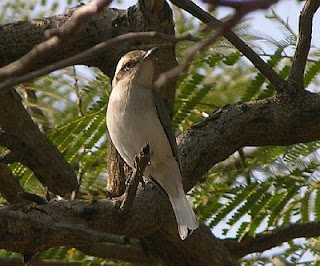Shrikes are passerine birds of the family Laniidae. The family name, and that of the largest genus, Lanius, is derived from the Latin word for "butcher" because of their feeding habits. Among its super family, the closest relatives of the Laniidae are the Corvidae (crows and allies).
 |
| Adult male |
The Southern Grey Shrike, Lanius Meridionalis, is a member of the Shrike family. It is closely related to the Great Grey Shrike, Lanius Excubitor, but the species do not interbreed and are separated by choice of habitat. This bird is not a common resident in Tamil Nadu, but I have viewed it several times in the open scrub country (which it prefers to habituate) of the Samudram Eri.
 |
| Bird Preening |
The Southern Grey has a narrow black forehead and broad face mask, grey mantle with white scapulars, broad white tips to secondaries, white sides tip to tail, and white underparts. Juveniles have sandy cast to grey upperparts, buff tips to tertials and coverts, and grey mask.
 |
| Bird in Flight from Above |
This bird eats small vertebrates and insects. Most important among invertebrate prey are insects, especially beetles, crickets, grasshoppers and bumblebees. To hunt it perches on an elevated spot in a conspicuous upright stance some distance above ground not only to watch for prey but also to advertise its presence to rivals. Alternatively this bird may scan land below during flight, staying in one place during prolonged bouts of hovering that may last up to twenty minutes.
 |
| Bird in flight from below |
This Shrike is medium-sized with a hooked beak reminiscent of a bird of prey. It has a harsh strident call. Prey is killed by hitting it with its beak, aiming for the skull in vertebrates. If too large to swallow in one or a few chunks, it is transported to a feeding site by carrying it in the beak or (if too large) in the feet.
It is then impaled upon a sharp point such as thorns or barbed wire or even just wedged between forking branches. These “larders” are typically around a metre above ground and although they can be found anywhere within the birds' territory generally tend to be in the general vicinity of the bird’s nest sites.
 |
| Eggs of the Southern Grey Shrike |
Shrikes are territorial and are generally monogamous. Males attract females to their territory with well stocked caches, which may include inedible but brightly coloured items. During courtship the male will perform a ritualised dance which includes actions that mimic the skewering of prey on thorns and will feed the female. To lay its eggs, Shrikes make simple, cup-shaped nests from twigs and grasses, in bushes and the lower branches of trees.
 |
| Juvenile Bird |






